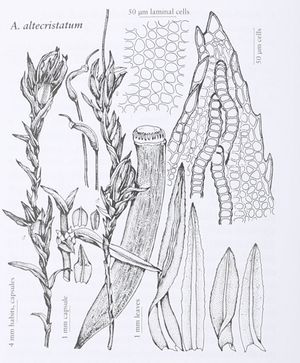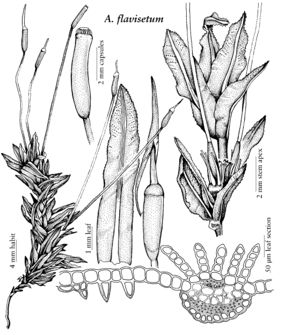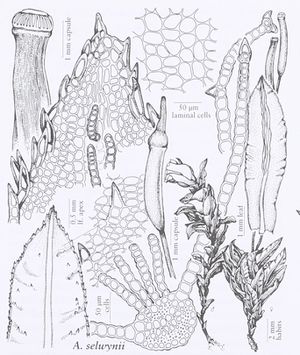Polytrichaceae
Plants small, medium to large, densely to loosely caespitose or scattered among other bryophytes, rarely with individual plants scattered on a persistent protonema. Stems erect, acrocarpous, from a ± developed underground rhizome, simple or rarely branched, bracteate proximally, grading gradually or abruptly to mature leaves. Leaves various, with a chartaceous, sheathing base and a divergent, firm-textured blade (polytrichoid), or the whole leaf membranous and sheath not or weakly differentiated, the blade rarely transversely undulate, crisped and contorted when dry; adaxial surface of blade with numerous closely packed longitudinal photosynthetic lamellae across most of the blade, the marginal lamina narrow, or the lamellae restricted to the costa, flanked by a broad, 1 (rarely 2)-stratose lamina, rarely with abaxial lamellae; margins 1(–3)-stratose, entire, denticulate, serrate, or toothed (in Atrichum bordered by linear, thick-walled cells); costa narrow in basal portion, in the blade abruptly broadened and diffuse, smooth or toothed adaxially, rarely with abaxial lamellae, in cross section with a prominent arc of large diameter guide cells and an abaxial stereid band; lamellae entire, finely serrulate, crenulate, or coarsely serrate, the free margin smooth or cuticular-papillose, the marginal cells in cross-section undifferentiated or sharply distinct in size and/or shape from those beneath; transition in areolation from sheath to blade gradual or abrupt, with “hinge-tissue” at the shoulders (except Atrichum and Psilopilum); cells of back of costa (or cells of the membranous lamina) typically in longitudinal rows, ± isodiametric to transversely elongate-hexagonal. Vegetative reproduction none, or by proliferation of an underground rhizome. Sexual condition dioicous or rarely monoicous; male inflorescence indeterminate, innovating from the center and continuing the growth of the stem, often several successive perigonia per shoot; female inflorescence terminal, perichaetial leaves long-sheathing or not much differentiated. Seta solitary or rarely several from the same perichaetium. Capsule obtusely to sharply (2–)4(–6)-angled, with indistinct longitudinal angles or ridges, or terete; hypophysis tapering and indistinct or delimited by a constriction at base of capsule; exothecium smooth, mammillose, or scabrous; stomata present (absent in Atrichum and Pogonatum); peristome pale or strongly pigmented, nematodontous, with a single series of [16–]32–64 rigid, unjointed teeth composed of elongate, fiber-like, sinuate cells, the teeth simple or compound, attached by their tips to the epiphragm (tympanum) covering the capsule mouth. Calyptra cucullate, with a matted felt of hairs arising from its tip and covering all or part of the capsule, or the calyptra sparsely ciliate to smooth. Spores minute and echinulate, or larger and finely papillose.
Distribution
Nearly worldwide.
Discussion
Genera 22, species ca. 260 (9 genera, 38 species in the flora).
The Polytrichaceae are widely distributed in all climatic zones except the lowland tropics and include many large, common, and familiar North American mosses. These “hair-cap mosses” have no close living relatives, and have a long (but disjunctive) fossil record (Eopolytrichum) from the Late Cretaceous of Georgia, United States (A. S. Konopka et al. 1997). The family is remarkable for the structural complexity of both gametophyte and sporophyte found in many of its members. The stems of robust taxa (Polytrichum) have a conspicuous central strand composed of hydrome and leptome, and traces extending into the leaves; in other genera the central strand is weak and indistinct.
The following descriptions use the shorthand term “polytrichoid” for taxa with a growth form and leaves like those of Polytrichum. The best analogy to the polytrichoid leaf is the grass leaf, with a clear distinction between a sheathing base and divergent blade. Typically a wedge-shaped group of transversely elongate, incrassate cells (“hinge tissue”) is present at the shoulders or just above. Most polytrichoid taxa have a hyaline-margined sheath, with a sharply defined border of thin-walled, decolorate cells. The leaves of Atrichum have a slender costa and a broad, membranous lamina. In Bartramiopsis and Lyellia, however, the lamellae are restricted to the “costa” and the broad “lamina” is 2-stratose. In the polytrichoid leaf the distinction between costa and lamina becomes blurred. The conducting strands are confined to a median band, flanked by an ambiguous zone bearing closely packed lamellae but only a few cells in thickness, and a narrow, usually 1-stratose marginal lamina. Gary L. Smith (1971) suggested that lamellae originally covered the adaxial surface of the leaf, and the broad membranous lamina developed as conducting strands and lamellae were restricted to the median portion.
As demonstrated by S. O. Lindberg (1868) the form of the marginal cells of the lamellae is often sufficient to distinguish between species of Polytrichaceae. Free-hand sections with a razor blade are adequate in most cases. Sections should be made from ordinary vegetative leaves, in the middle 1/3 (or in polytrichoid leaves, midway between the tip and the base of the blade). Lengths of lamellae should also be scraped from the leaves to be viewed in profile. Median cells of the lamina are best measured individually. The leaf cells are typically aligned in ± regular longitudinal rows, but it is difficult to measure a group of cells and divide to obtain an average cell width since the cells are not aligned transversely.
The peristome teeth are unique among mosses in being composed of compact bundles of whole, fiber-like cells. The teeth are not composed of remnants of wall thickenings as in arthrodontous mosses, but form by intrusive growth and elongation of living cells. Accordingly, the peristomes are not homologous. The teeth may be simple (with a single median line), or compound (the outlines of two teeth visible on the outer face of each tooth), although the exact nature of this difference is not well understood. The sinus between these “teeth” may be broad (Oligotrichum), or narrow and obscured (Pogonatum). The height of the peristome is measured from the tips of the teeth to the capsule rim, seen from without. The term “basal membrane” is not used. The generic classification used in this treatment follows that of Gary L. Smith (1971) with few modifications.
Selected References
Lower Taxa
Illustrations
| Family ⠉ | Taxon | Illustrator ⠉ | |
|---|---|---|---|
 | Polytrichaceae | Atrichum altecristatum | Patricia M. Eckel |
 | Polytrichaceae | Atrichum flavisetum | Patricia M. Eckel |
 | Polytrichaceae | Atrichum selwynii | Patricia M. Eckel |
| ... further results | |||
Key
| 1 | Protonema persistent; individual leafy plants small and scattered. | Pogonatum |
| 1 | Protonema ephemeral; leafy plants gregarious, loosely tufted or caespitose | > 2 |
| 2 | Lamellae 10 or fewer and confined to median portion of blade, often loosely spreading and wavy | > 3 |
| 2 | Lamellae 20 or more, occupying most of the leaf width, compact and straight | > 7 |
| 3 | Lamina 2-stratose, ± firm, the upper layer of laminar cells strongly mammillose | > 4 |
| 3 | Lamina 1-stratose, broad and membranous, the cells not mammillose above (or if mammillose, then the leaf bordered by thick-walled elongate cells) | > 5 |
| 4 | Margins of sheath entire; lamellae entire; leaf tip with a slender, caducous hair; plants polytrichoid. | Lyellia |
| 4 | Margins of sheath ciliate; lamellae coarsely serrate; leaf tip not ciliate; plants slender and wire-like. | Bartramiopsis |
| 5 | Leaf margins bordered by narrow, thick-walled cells, sharply toothed; lamina often transversely undulate, the back of lamina with diagonal rows of teeth; abaxial lamellae absent. | Atrichum |
| 5 | Leaf margins serrulate to entire, not bordered by narrow, thick-walled cells; lamina not undulate and not toothed on back; abaxial lamellae often present | > 6 |
| 6 | Leaves not hyaline-margined; well-developed abaxial lamellae often present on both costa and lamina | Oligotrichum |
| 6 | Leaves narrowly bordered in part by thin-walled, hyaline cells; abaxial lamellae absent or restricted to costa near leaf apex. | Psilopilum |
| 7 | Margins of lamellae papillose (or appearing so in cross-section) | > 8 |
| 7 | Margins of lamellae smooth | > 11 |
| 8 | Leaf sheath not hyaline-margined; marginal cells of lamellae rectangular and flat-topped | Pogonatum |
| 8 | Leaf sheath hyaline-margined; marginal cells of lamellae rounded to elliptic to pyriform | > 9 |
| 9 | Marginal cells in profile irregularly striolate and pitted. | Meiotrichum |
| 9 | Marginal cells in profile distinctly papillose, with rounded papillae | > 10 |
| 10 | Marginal cells pyriform, lateral walls strongly thickened, lumen narrowly pentagonal. | Polytrichastrum |
| 10 | Marginal cells elliptic, thick-walled, the distal wall broadly convex. | Pogonatum |
| 11 | Marginal lamina greatly expanded and sharply inflexed, entire, overlapping and enclosing the lamellae, the cells transversely elongate. | Polytrichum |
| 11 | Marginal lamina narrow, serrate or toothed (if subentire then not broadly inflexed, the cells ± isodiametric) | > 12 |
| 12 | Lamellae ± entire in profile, the apical cells rounded in cross-section, only slightly taller than those beneath, or transversely ovate | > 13 |
| 12 | Lamellae crenulate in profile, the apical cells differentiated, retuse or flat-topped in cross-section | > 14 |
| 13 | Leaves with a distinct sheathing base and a firm, divergent blade, the sheath entire, hyaline-margined. | Polytrichastrum |
| 13 | Leaves lax, only weakly differentiated into sheath and blade, toothed nearly to the base, not hyaline-margined. | Pogonatum |
| 14 | Costa rounded in cross-section, forming a low ridge on back of blade, the arc of guide cells narrow (8-12 cells wide); median sheath cells short-rectangular (to 5:1) to rhomboidal | Polytrichastrum |
| 14 | Costa in cross-section broad and flat, the arc of guide cells 18-24 cells wide; median sheath cells linear (as 20:1). | Polytrichum |